Advertisement
Commentary
Everything old is new again in the MFA’s transformed art galleries of Ancient Greece, Rome and the Byzantine Empire
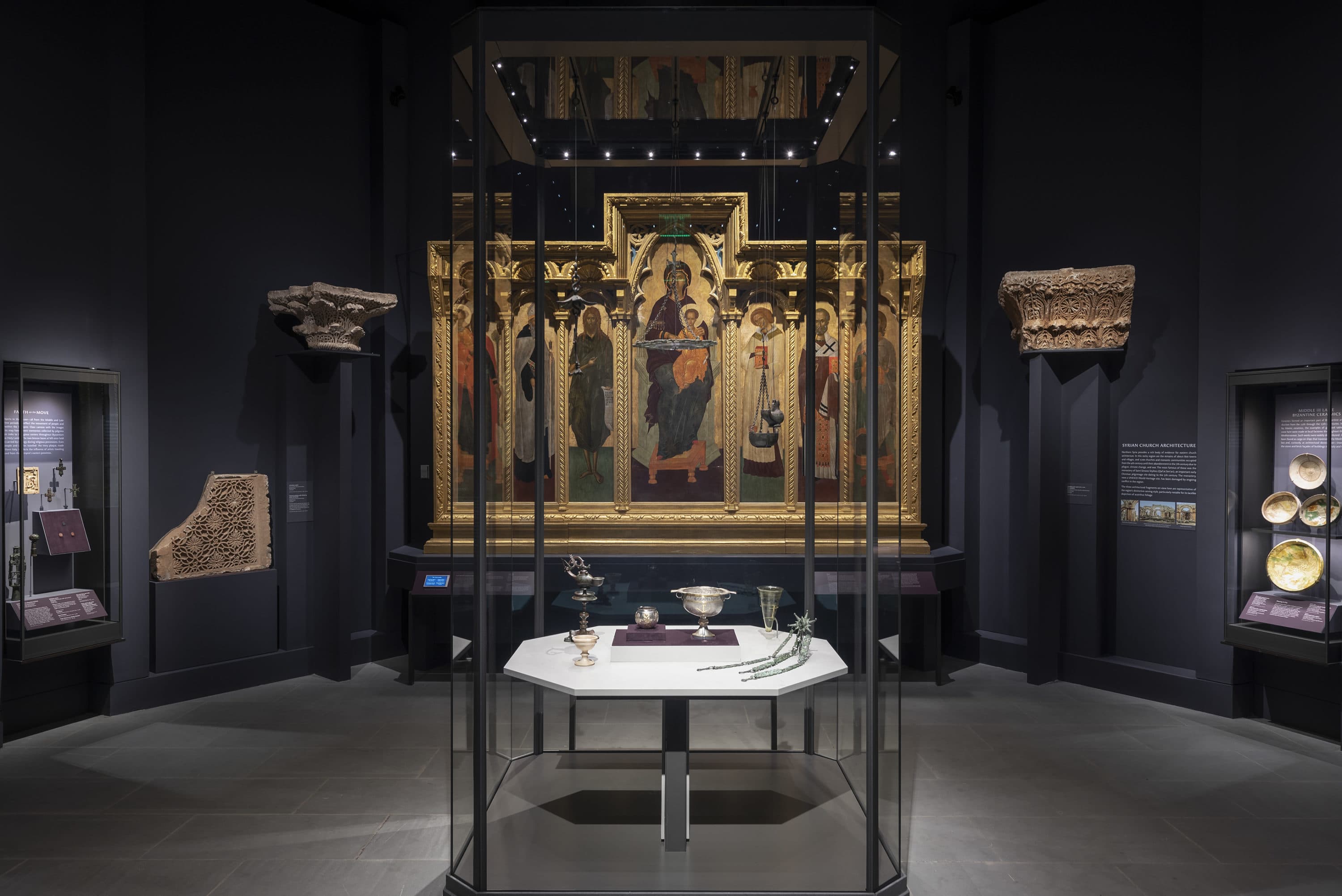
Five “reimagined” galleries at Boston’s Museum of Fine Arts have now opened to expand the display of the museum’s impressive collection of art from the ancient world, fulfilling the longtime vision of MFA curator Christine Kondoleon. And these “new” galleries really help us see ancient art and the museum’s collection with fresh eyes.
The entryway is right off the second-floor rotunda. An introductory antechamber (not big enough to be a room) offers a couple of key aspects of the ancient world. One presents the Greek and Roman empires as ancient superpowers. Under the heading “Visualizing Others,” a small marble statue called “Captive Barbarian” demonstrates “the Romans’ genuine fascination with the peoples they conquered, while reinforcing their own sense of superiority.” On the opposite side of the entryway, we get hints of the ancient view of art itself, including music and poetry. A third-century BCE Greek ceramic mixing bowl and, 500 years later, a Roman marble, each depict the legend of Marsyas, the satyr who challenged Apollo, the god of music, to a contest and, of course, lost — the penalty for which was being skinned alive.
This excruciating legend about the cost of making art remained a subject for artists for centuries. Perhaps its greatest depiction is Titian’s hair-raising final painting, the life-size “Flaying of Marsyas.” And speaking of Titian, if you managed to see the recent Titian show at the Gardner, you might remember the “Diana and Actaeon” painting, in which a young hunter stumbles upon the goddess and her votaries bathing and foresees the angry goddess turning him into a stag and being devoured by his own hunting dogs. In the first of the new galleries at the MFA, Gods and Goddesses, there’s a beautifully preserved fourth-century BCE krater (mixing bowl) with the very same scene, and even more explicit.
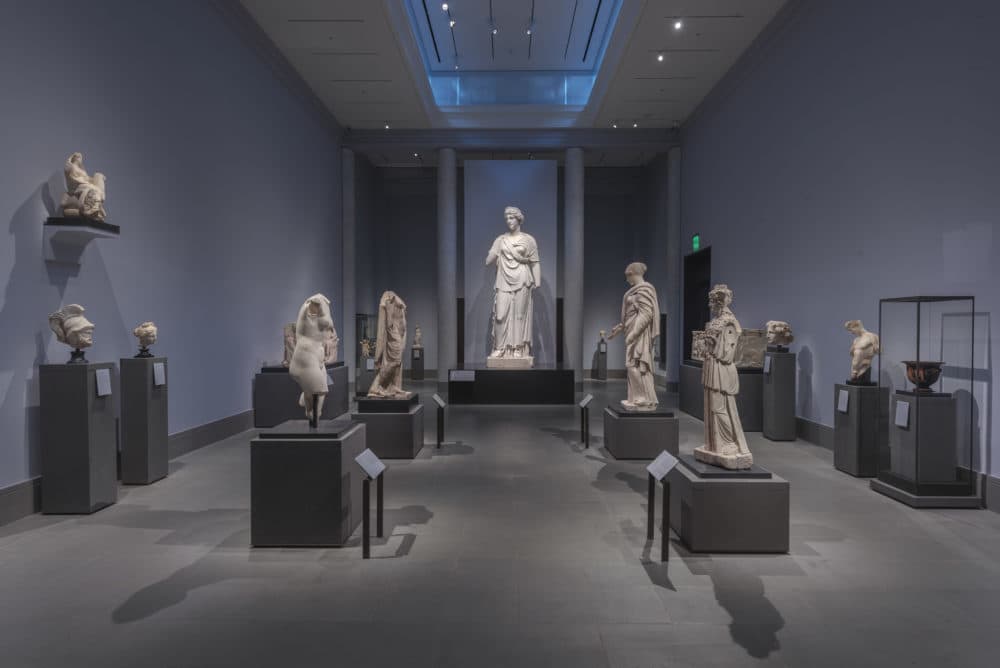
You might, like me, gasp with astonishment as you walk through the entryway into that first gallery, the largest and most spectacular room among the new galleries. The ceiling has now been raised six feet and daylight filters in through skylights. Monumental new decorative columns convey the impression that we’re in the central open space of an ancient temple.
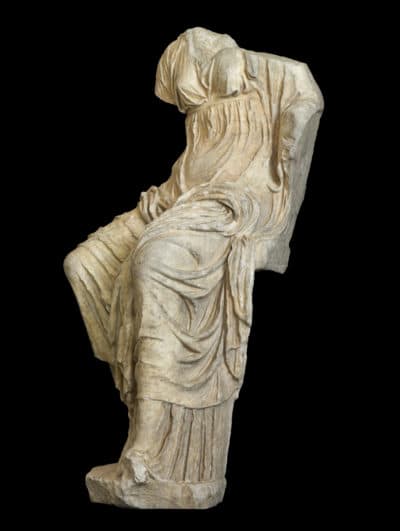
The first object in the room is a magnificent marble head of Zeus from late classical Greece (around 350 BCE, but looking much more modern). But on the far side of this temple room is one of the most astonishing objects in the entire museum — a 13-foot-high standing goddess from the first century BCE — probably one of the nine Muses, though her head, an image of Juno, was probably attached to this colossal headless body sometime in the 17th century. Around 1904, it was purchased by Mary Pratt Brandegee and installed in her Italian garden in Brookline. The MFA acquired it in 2011. It’s the largest Roman statue in the United States, overwhelming in its grandeur and authority. Experts think it’s from a group of giant sculptures of Apollo and his nine muses commissioned by Augustus before he became emperor. The other pieces from this group are still in Italy.
But Zeus and Juno are not the only notable works in this room. Another massive marble Muse, in storage for decades, sits enthroned and headless.
There’s a bewitching statue of Hygiea — goddess of health — with a snake (a symbol of health) twisting around her upper body, a Roman copy (130-161 CE) of a fourth-century BCE Greek bronze (it’s on loan from the Los Angeles County Museum of Art, so it won’t be in Boston forever).
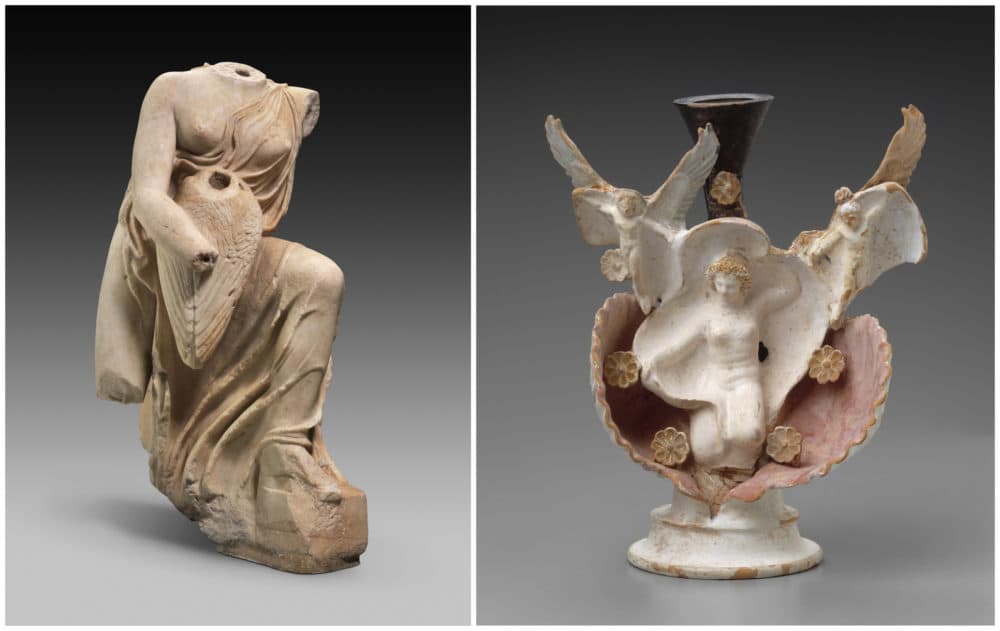
High up on a wall, placed at the angle from which it would have been originally viewed, is a smaller marble, circa 400 BCE, of “Leda and the Swan” (another poetic reference), with Leda both erotically topless, in a diaphanous gown, and not-so-erotically headless, and the swan (Zeus in disguise) neckless.
One of the most ravishing objects among the gods and goddesses in this room is a fourth-century-BCE ceramic oil flask only a few inches tall depicting the birth of Aphrodite, as she is being scooped by winged figures (winds?) out of a seashell (think of the Venus Botticelli painted nearly 1,900 years later!).
Even older (460 BCE) is the so-called “Boston Throne” — a three-sided marble relief. On the broad front side is, the wall-copy explains, either Love or Death weighing two young men on a now-missing scale. On the left, Aphrodite, with a dolphin barely visible beneath her plushly cushioned throne, seems pleased at the outcome; on the right, Persephone mourns. Love seems to have won over Death. Even more beautiful is the figure on one side of this piece, a young man playing a lyre. Only two such three-sided reliefs have ever been found — and in the same part of Greece. Their function remains something of a mystery — perhaps, as the wall text guesses, this may be a “decorative windscreen for an altar.” The mystery is part of its unquestionable beauty.
Advertisement
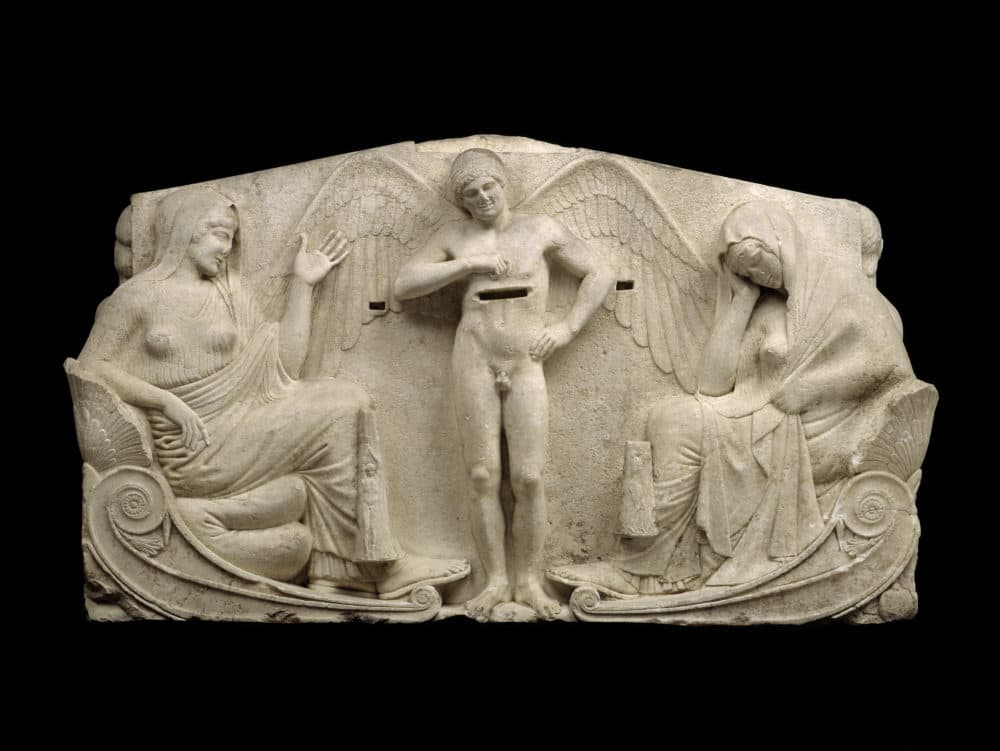
One important installation in the Gods and Goddesses gallery is both informative and fun — and it provides a welcome splash of color to the elegant but austere gray room (all but one of the newly transformed galleries are some shade of gray). We’re so used to seeing classical marbles as white, it’s almost a shock to learn that “their original appearance was quite colorful, even garish by today’s standards.” In the center of this gallery is the museum’s elaborately decorated “Athena Parthenos,” a late Roman copy, six feet tall, of the lost 39-foot statue of Athena in the Parthenon (almost a miniature compared to the towering Juno in this gallery). On the wall near this statue is a video screen that shows what the original probably looked like: not palely monochromatic but with pink flesh, red lips, brown hair and dark eyebrows — the goddess wearing a crimson gown with a gold collar and belt, and an ornate gold headdress. We’re encouraged to examine closely the statue itself (and other pieces here as well) for traces of original pigment.
The MFA is quite explicit about its intention to refute the propaganda from white nationalists that dates the idea of the superiority of whiteness back to the classical world. Ancient hierarchical distinctions, we’re informed in no uncertain terms, “were not based on skin color.” “White” was “a racial concept that did not exist in antiquity.”
Perhaps less overwhelming than the Gods and Goddesses room but of comparable importance are the new spaces devoted to Early Greek Art and Roman Portraiture (busts of emperors and commoners alike). These join the five galleries that have previously opened within the past decade: Daily Life in Ancient Greece, Homer and the Epics (more references to poetry), Dionysus and the Symposium, Theater and Performance, and Ancient Coins. A close look will reveal countless treasures. How can I not mention an archaic fifth-century BCE stone architrave relief from the Temple of Athena at Assos (in Turkey), which depicts Heracles fighting the centaurs, and is placed on a raised beam to suggest its original location? Or little tchotchkes from daily life like an ancient bronze key or gong? Or the display case of horrifying and hilarious body parts and fragments?
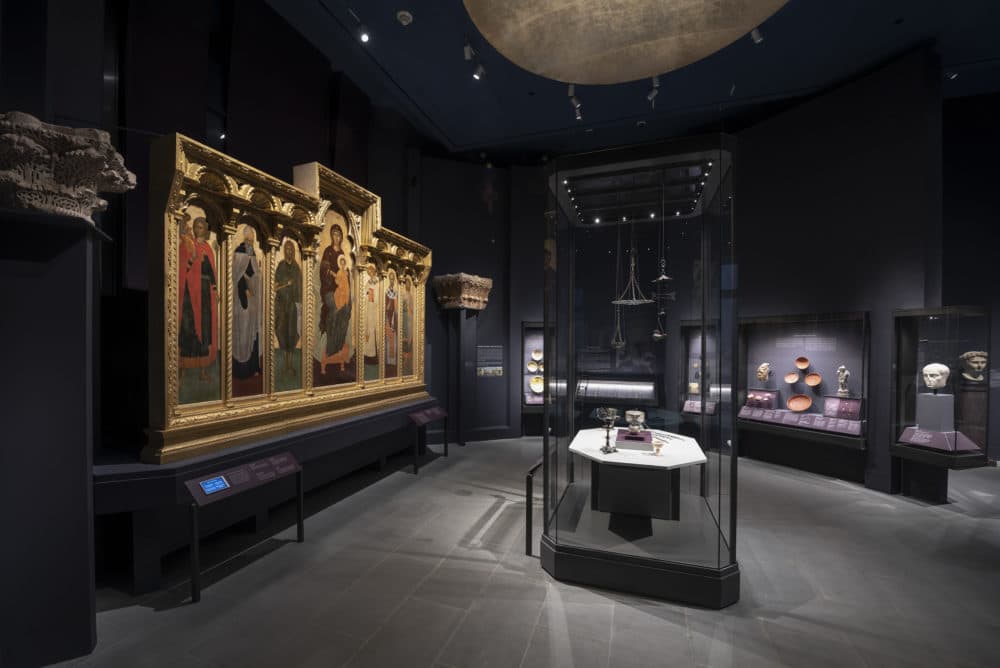
There are two more newly renovated galleries that I haven’t mentioned yet, and though they are on a relatively smaller scale, each is impressive in its own, quite opposite way.
One is the new Byzantine Empire gallery — our first contact with Christian art. It’s the first Byzantine gallery in New England and a rare collaboration among four different branches of this encyclopedic museum: Egyptian, Greek and Roman, Art of Europe, and Textiles. Suddenly, after all those white and gray rectangles, we’re in an octagon, inspired by the central floor plan of Eastern churches — a dark room, but glittering with gold and silver, bronze and copper, glass, ivory, and scintillating gemstones — overhead a facsimile of a gold dome.
The centerpiece here is the 10-foot-wide 15th-century “Monopoli Altarpiece,” seven dazzling panels in tempera and gold by an unknown Greek icon painter — the Madonna and Child flanked by three saints on each side. And this is only one of close to 200 objects filling this relatively small room.
The last of the newly renovated galleries, 20th- and 21st-Century Art, with the palest of off-white walls, is the most surprising --and, in some ways, most daring. Elsewhere in these galleries is a startling untitled piece from 1997 by the late Greek Italian sculptor Jannis Kounellis — a narrow steel I-beam with the sculptor’s worn shoes attached at either end. It’s a kind of self-portrait, both soulful and weaponlike, and oddly fits into the context of the ancient art surrounding it. It also seems a set-up for the final gallery of exclusively modern art.
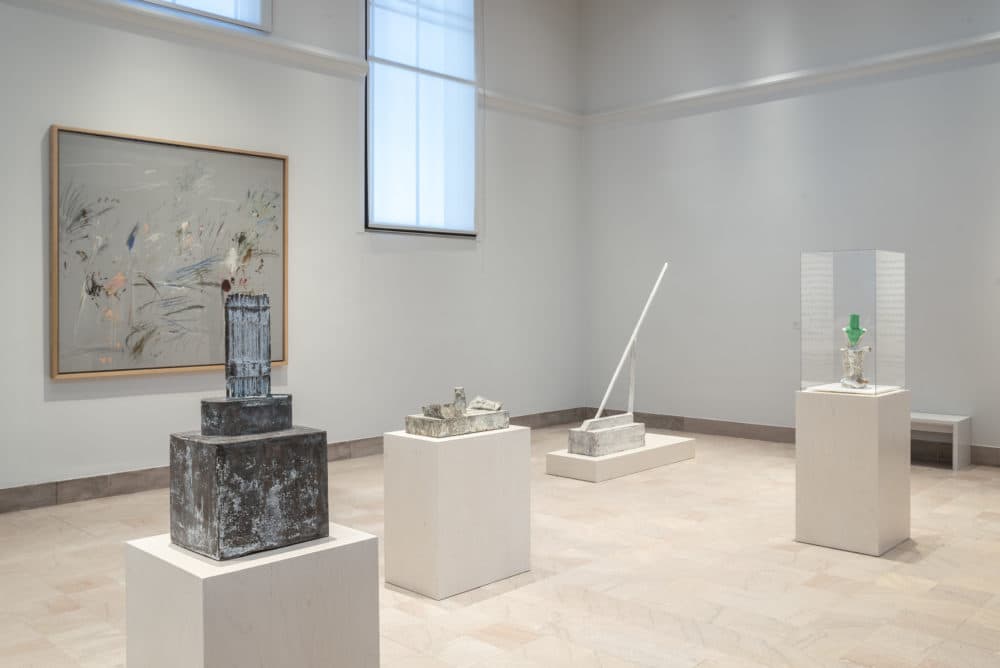
The first of the rotating installations here is devoted to the sculptures (relatively lesser-known than his paintings) by the American artist Cy Twombly (1928-2011), with one major early abstract painting (“Il Parnasso” — or “Parnassus” — from 1964, a promised gift to the MFA). Twombly, who studied at the Museum School in the late 1940s, was fascinated and influenced by ancient art and poetry, and became an important collector. He worked for the U.S. Army as a cryptographer in the 1950s, and his seemingly free-spirited paintings include a distinctive element of calligraphy. Among his subjects (not in this show but related to some of the ancient works in the other galleries) are series devoted to “Leda and the Swan” and “The Birth of Venus.” The museum’s note for an untitled 2002 sculpture here indicates why this modern art gallery is an important adjunct to the classical galleries: “The end result is akin to readymade archeological fragments. This work is also topped with a shock of green paint — as vivid as we now understand ancient polychrome sculptures to have been.”
“What I am trying to establish,” Twombly wrote in 1952, “is — that Modern Art isn’t dislocated, but something with roots, tradition and continuity. For myself the past is the source (for all art is vitally contemporary).” Seventy years before the opening of this gallery, Twombly threw down the gauntlet, urging us to contemplate the connections between the most diverse periods and kinds of art. An exhibition appropriately called “Cy Twombly: Making Past Present,” organized by the MFA and the Getty Museum, will be coming to Boston Jan. 14, 2023. I’m already curious to see who or what will follow Twombly.
And two more galleries — for Hellenistic and Etruscan art — are still to be completed.
